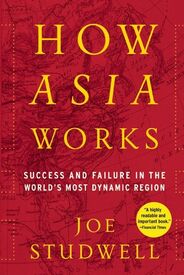How Asia Works

Success and Failure in the World's Most Dynamic Region
by Joe Studwell
Completed: June 27, 2021- Other
- 320 pages
- ISBN: 9780802119599
- Goodreads page
Many of the early parts of this book weren’t the easiest read - not because it’s dense (which it is, in a good way) but the writing isn’t always the best. But the quality of the material itself is fantastic, and it is well worth going through the book. Skim a few parts here or there if you have to, but read as much of it as possible that you find interesting. Highly recommended. It’s an old-ish book at this point, but still very good and relevant.
There are many good reviews online, almost all tend to highly recommend it. See Tyler Cowen’s review for example. Bill Gates also has a decent review and brief synopsis of the book - which is a bit strange since much of the book argues that the types of policies much of the Western world, including perhaps much of the Gates Foundation, tries to impose on developing nations is flawed.
As noted more comprehensively in the Bill Gates review, the main gist of the book is that the northeast Asians that developed well followed mostly a similar pattern -
1) focus on household farming rather than large scale mechanized farming especially when you have surplus labor available. Land rights and redistribution policy is critical here. As is ensuring that there is large scale storage, distribution and marketing infrastructure available for the household farmers to use.
2) Strong industrial policy, with a protectionist bent, is important. The two keys here are - ensure there is technological transfer and learning (not just licensing technology from foreign companies), and if you’re going to protect domestic manufacturers then impose export discipline. Require them to export a lot in order to receive the subsidies. Exports becomes a good benchmark.
3) Finance matters less. Even if you screw it up, as long as you get the first two right & finance is used somewhat in the pursuit of those two, you’ll be fine. However, if you get those two wrong, then doesn’t matter how sound your financial policies and infrastructure is.
Or, as I like to put it even more simply - a) feed your people well, and b) keep asking yourself the question: are we making things that other people in the world want? If so, continue. If not, keep trying to. Everything else is secondary. Encourage your entrepreneurs who are developers of technological capacity, not those who are effectively asset traders.
I have a lot of useful excerpts from the book. I’ll try to write them up here at some point, but in the mean time, here are a couple of salient ones:
…[A] government’s industrial strategy is the most powerful determinant of success. If a state does not force the creation of firms that can be the vehicles for industry learning - and then nurture them -all efforts at formal education may go to waste.
And some quotes that India should be keen to pay attention to:
…[A]ny country which bases its development policy on its service sector faces higher barriers to exports than one with a traditional manufacturing-oriented policy. It should be no surprise that the share of services in total world trade has been stuck at around one-fifth for the past two decades.
In the automotive industry, developing country car makers around the world have found it almost impossible to gain technological independence after going into equity joint ventures with global auto firms. In joint ventures, it is too easy and too comfortable for the local entrant to become dependent on drip-fed technology from a foreign partner, while multinationals have no interest in helping local firms export.
There are those who hope that India, with its much-vaunted IT service sector, represents an alternative to manufacturing-led development. Firms like Infosys and Tata Consultancy Services (TCS) are world-beaters. But twenty years after India launched its current reform agenda in 1991, only 3 million people out of a population of 1.2 billion work in IT - a fraction of 1 per cent of the labour force. The service entrepreneurs, managers and technicians who graduate from the elite Indian Institutes of Technology and run firms like Infosys and TCS create far fewer jobs for others than they would had they been forced to manage factories. Two decades of industrial policy neglect in India have created a situation in which only 14 per cent of the labour force is employed in the manufacturing sector. After twenty years of industry-based development in South Korea, 30 per cent of the working population had already been drawn into industry. There is no way that the specialist IT firms of Bangalore, or the financial services elite of Mumbai, will propel India as a nation to the kind of developmental success seen in Japan, Korea, Taiwan and China. It is not going to happen in a comparable timeframe, and punditry that likens India’s economic development to that of the more northerly countries is fatuous.
All book cover images are from Goodreads unless specified otherwise.